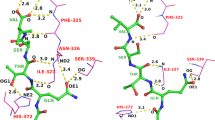Abstract
In this work, we validate and analyze the results of previously published cross docking experiments and classify failed dockings based on the conformational changes observed in the receptors. We show that a majority of failed experiments (i.e. 25 out of 33, involving four different receptors: cAPK, CDK2, Ricin and HIVp) are due to conformational changes in side chains near the active site. For these cases, we identify the side chains to be made flexible during docking calculation by superimposing receptors and analyzing steric overlap between various ligands and receptor side chains. We demonstrate that allowing these side chains to assume rotameric conformations enables the successful cross docking of 19 complexes (ligand all atom RMSD < 2.0 Å) using our docking software FLIPDock. The number of side receptor side chains interacting with a ligand can vary according to the ligand’s size and shape. Hence, when starting from a complex with a particular ligand one might have to extend the region of potential interacting side chains beyond the ones interacting with the known ligand. We discuss distance-based methods for selecting additional side chains in the neighborhood of the known active site. We show that while using the molecular surface to grow the neighborhood is more efficient than Euclidian-distance selection, the number of side chains selected by these methods often remains too large and additional methods for reducing their count are needed. Despite these difficulties, using geometric constraints obtained from the network of bonded and non-bonded interactions to rank residues and allowing the top ranked side chains to be flexible during docking makes 22 out of 25 complexes successful.

Similar content being viewed by others
References
Ahmed A, Kazemi S, Gohlke H (2007) Protein flexibility and mobility in structure-based drug design
Zhao Y, Sanner MF (2007) Proteins 68:726
Zhao Y, Stoffler D, Sanner M (2006) Bioinformatics 22:2768
Morris G, Goodsell D, Halliday R, Huey R, Hart W, Belew R, Olson A (1999) J Comput Chem 19:1639
Najmanovich R, Kuttner J, Sobolev V, Edelman M (2000) Proteins 39:261
Gutteridge A, Thornton J (2005) J Mol Biol 346:21
Fradera X, de la Cruz X, Silva CHTP, Gelpi JL, Luque FJ, Orozco M (2002) Bioinformatics 18:939
Huey R, Morris GM, Olson AJ, Goodsell DS (2007) J Comput Chem 28:1145
Leach AR (1994) J Mol Biol 235:345
Kallblad P, Dean PM (2003) J Mol Biol 326:1651
Frimurer TM, Peters GH, Iversen LF, Andersen HS, Moller NPH, Olsen OH (2003) Biophys J 84:2273
Ala PJ, DeLoskey RJ, Huston EE, Jadhav PK, Lam PY, Eyermann CJ, Hodge CN, Schadt MC, Lewandowski FA, Weber PC, McCabe DD, Duke JL, Chang CH (1998) J Biol Chem 273:12325
Österberg F, Morris G, Sanner M, Olson A, Goodsell D (2002) Proteins 46:34
Huang S-Y, Zou X (2007) Proteins 66:399
Sanner MF (2005) Structure 13:447
Sanner MF, Olson AJ, Spehner J-C (1996) Biopolymers 38:305
Acknowledgments
The financial support from NIH Grant BISTI, GM65609, 2003–2007 and NIH RR08605 are appreciated. This work was partially supported by the National Center for Supercomputing Applications under TG-ASC070027N and utilized the TeraGrid Tungsten machine. This is manuscript 19007-MB from the Scripps Research Institute.
Author information
Authors and Affiliations
Corresponding author
Rights and permissions
About this article
Cite this article
Zhao, Y., Sanner, M.F. Protein–ligand docking with multiple flexible side chains. J Comput Aided Mol Des 22, 673–679 (2008). https://doi.org/10.1007/s10822-007-9148-5
Received:
Accepted:
Published:
Issue Date:
DOI: https://doi.org/10.1007/s10822-007-9148-5




